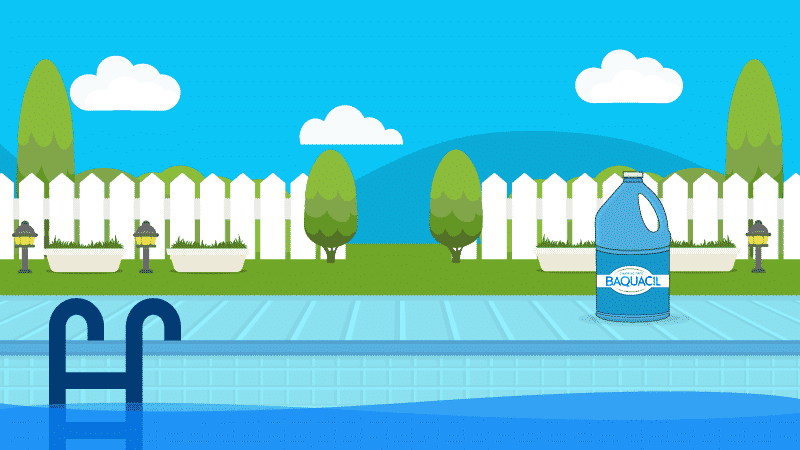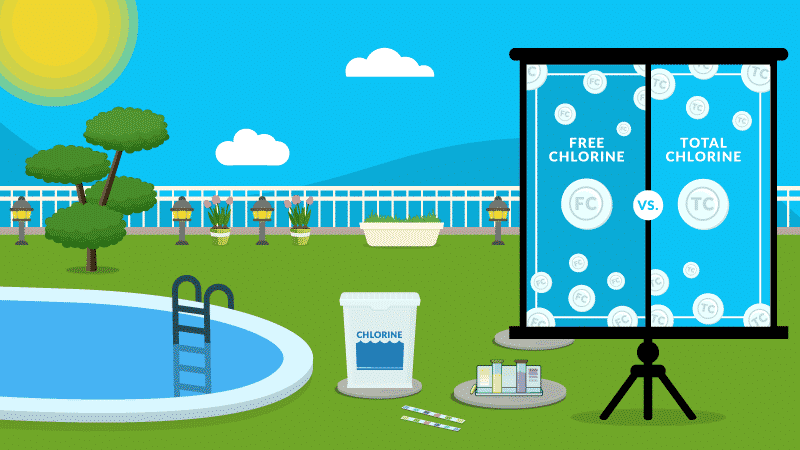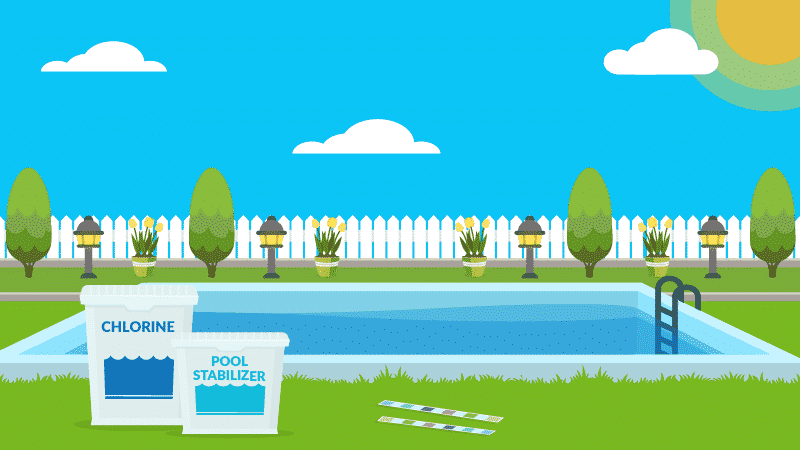The Best Chlorine Tablets for Your Pool (and How to Safely Add Them)
Chlorine tablets are one of the most convenient, hands-free ways to sanitize your swimming pool. Unlike liquid chlorine or granular chlorine, chlorine tablets (also known as chlorine pucks) dissolve slowly over time.
Coming in two sizes (either 1-inch or 3-inch pucks), chlorine tablets are pre-dosed and already contain a chlorine stabilizer (a.k.a. cyanuric acid or CYA).
If you’re a pool owner with a larger pool of over 5,000 gallons, you’ll want to use 3-inch chlorine tablets.
Stock up and save money on chlorine tablets for the season by getting the standard 3-inch stabilized chlorine pucks.
But if you have a smaller pool, like an Intex pool or a pool 5,000 or less, you’ll want to use 1-inch chlorine tablets instead. While technically, you can use a single 3-inch puck for 5,000 gallons of water, it’s easy to accidentally over-chlorinate if your tablets are too large.
In the right applicator, like an automatic chlorinator, chlorine tablets provide a steady supply of chlorine to your pool water. And they’re easier to handle and store than granular or liquid chlorine.
But there are some downsides to chlorine pucks. They can drastically lower your pH and alkalinity levels, which can irritate swimmer skin and eyes and erode pool surfaces and equipment.
They can also raise your cyanuric acid levels over time since each puck is stabilized. And high cyanuric acid levels can impact your chlorine’s effectiveness. It all depends on what chlorine tablets you use, how you add them to your pool, and how often you test your water.
So here’s how to choose the right chlorine tablets based on your pool size and how to add them safely.
Stop wasting time and money with confusing water chemistry and maintenance. Our effortless system guarantees to keep your pool balanced, sanitized, and crystal clear all year. Works for all pools including saltwater.
What’s the Difference Between Pool Chlorine Tablets and Other Types of Chlorine?
Pool chlorine comes in three common forms: tablets, granules, and liquid.
Chlorine Tablets
Also known as pucks, chlorine tabs contain chlorine and a stabilizing component like cyanuric acid or CYA. They usually come in 1-inch or 3-inch pucks and are placed in floating chlorine dispensers, pool skimmers, or automatic chlorinators.
Because these pucks are slow-dissolving, long-lasting, and provide sustained chlorination, they’re more convenient compared to adding granules. Trichlor chlorine tablets contain up to 90 percent chlorine (compared to granules). They will also affect your pool’s pH and alkalinity.
Chlorine Granules
Granular chlorine dissolves quickly in water, helping fight algae and contaminants fast. It’s added directly to your pool, giving you complete control of the dosage. But since you have to measure and add it yourself, it’s more dangerous and cumbersome to handle.
And granules won’t work in automatic feeders, since they dissolve too quickly. Granules are usually made of dichlor chlorine, containing a lower percentage of chlorine than tablets (around 60 percent).
Liquid Chlorine
Liquid chlorine or bleach contains the same main ingredient as other pool chlorine (sodium hypochlorite). It’s cheaper than tablets and granules, but it’s unstabilized. That means you’ll need to add a stabilizer, also known as cyanuric acid, to protect the chlorine from breaking down in the sun.
And this type of chlorine has an extremely high pH and is highly corrosive. Finally, it doesn’t have a long shelf life and you’ll need to add a lot of it since liquid chlorine only contains 10-12% chlorine and bleach only contains 3-6% chlorine.
The ideal chlorine level in your swimming pool
Your free chlorine levels should be 1 to 3 PPM (parts per million), with 3 PPM of free and available chlorine being ideal. Even if you use slow-dosing chlorine tablets, you’ll want to test your pool water once per week to make sure your pH, alkalinity, and chlorine are within range. The wrong chlorine levels can cause eye and skin irritation, algae growth, or cloudy water.
How to Choose the Right Chlorine Tablet Size: 3-inch vs. 1-inch
Tablets typically come in two sizes: 3-inch or 1-inch chlorine tablets. As a general rule, one 3-inch tablet will sanitize 5,000 gallons of pool water.
One-inch tablets dissolve more quickly since they are smaller and have less surface area for the water to pass over. They’re great for smaller inground and above ground pools.
While you technically could add a single 3-inch puck to a 5,000-gallon pool, it’s easy to over-chlorinate a smaller body of water. Using multiple 1-inch tablets is a better way to control dosing.
Three-inch tablets, on the other hand, are easier to handle and dissolve more slowly than 1-inch tablets. They’re better for larger pools since a single 3-inch tablet can sanitize up to 5,000 gallons. And they’re the best size to use in an automatic chlorinator.
While this is a more hands-off approach to sanitizing your pool, you’ll still have to regularly measure your water chemistry levels. Remember, chlorine tablets can lower pH and alkalinity levels and raise your cyanuric acid levels over time.
If you don’t already know how much water your pool holds, check out our easy-to-use pool calculator to figure out your pool volume.
 Rectangle
Rectangle
 Round
Round
How to Choose the Best Chlorine Tablets for Your Pool
Regardless of the brand you choose (including Clorox, HTH, In The Swim, etc.), most 3-inch or “jumbo” chlorine tablets are made of trichlor chlorine. Containing up to 90 percent chlorine, solid trichlor chlorine tablets also contain cyanuric acid (CYA) that stabilizes the chlorine and protects it from breaking down in the sun.
Once a tablet dissolves in the pool water, the treatment resists degradation under direct sunlight and UV light, slowing the production of chloramines.
Most chlorine tablets contain the same ingredients so you won’t see many variables across brands.
But be sure to double-check the ingredients and the size of the tablets (1-inch vs. 3-inch). And make sure that your chlorine pucks come in a properly sealed container or bucket. Some chlorine tablets come individually wrapped inside the containers as well.
Do not use chlorine tablets if you have an indoor pool!
Chlorine tablets contain cyanuric acid to protect chlorine from breaking down in the UV rays of the sun. But it will build up over time in an indoor pool, which does not need any CYA.
How to Add Chlorine Tablets to Your Pool
There are three common ways to use pool tablets: using an automatic chlorinator, inside a floating dispenser, or placed in your skimmer basket. Remember that other things like your pool water temperature and water pressure can impact the amount of time it takes your tablet to dissolve.
And a larger, 3-inch tablet will break down more slowly than a 1-inch tablet. We recommend using an automatic chlorinator or a floater for your chlorine tablets.
1. Automatic Chlorinators (Best Option)
An automatic chlorinator, also known as a chemical feeder, is the most reliable option for using chlorine tablets. Simply add several tablets to the chlorinator and set the rate you want the tablets to dissolve. Installed directly into your pump and filter system, a chlorinator disperses a steady, measured amount of chlorine or bromine into the water before it returns to your pool.
Chlorinators use water pressure to dissolve pucks at a steady rate. Keep in mind that these pucks or tablets will only dissolve in your chlorinator when your pool pump is running. If your pump is on a timer and turns off, your tablet will not dissolve and therefore it won’t disperse into your pool.
This automatic chlorinator is perfect for the pool owner who hates fussing with chlorine tablets. With its dial control valve, you can easily adjust the chlorine level depending on your pool's size.
2. Floating Dispensers (Second Best Option)
Chlorine floaters are plastic pool gadgets that travel around your pool, dispersing sanitizer as the tablets inside dissolve. They’re convenient and low-maintenance. But they dispense chlorine or bromine unevenly, so your levels may fluctuate.
They can also get stuck in one spot in your pool, like behind ladders, causing them to dispense too much sanitizer in one spot. And that can discolor and even damage your pool liner.
40% Thicker Walls, 7-inch Large Chlorine Dispenser For Inground and Above Ground Swimming Pool, 2 Year Warranty (For 3-inch Chlorine Tablets).
3. Tablets Inside the Skimmer Basket (Not Recommended)
With a continuous water flow through the filter, placing tablets in your skimmer provides a steadier dissolving rate. As water flows through, it will break down the tablet and send sanitized water through your filter system and back into your pool.
But the tablets will dissolve even when the filter isn’t running. Sanitizer can collect in and near the skimmer basket, causing stains, erosion, and equipment damage.
Whenever adding chlorine tablets to your water, be sure to test and balance your other chemical levels. Make sure your alkalinity is between 100 and 150 PPM and your pH is between 7.4 and 7.6. Your alkalinity will impact your pH, and your pH can impact the effectiveness of your chlorine.
Also, be sure your cyanuric acid levels should be between 30 and 50 PPM. Adding chlorine tablets to your pool water increases your CYA levels.
If you need more help with pool chemistry (including water balancing, sanitizers, algaecide, and more), check out our guide on Basic Pool Chemistry 101.
How Many Chlorine Tablets Should I Use in my Pool?
A 3-inch chlorine tablet can sanitize up to 5,000 gallons of water. So if you have a 20,000-gallon pool, you’ll want to use four 3-inch chlorine tablets.
To calculate the right number of tablets, round your pool volume up to the nearest 5,000 gallons. And if you have a smaller pool (under 10,000 gallons), consider using 1-inch chlorine tablets. It’s easy to over-chlorinate a smaller body of water.
Check your automatic chlorinator or floater each week and test your water chemistry using a test strip or liquid test kit. Balance your pH and alkalinity and monitor your chlorine and cyanuric acid levels.
If your chlorine or CYA is too high, you’ll need to use fewer chlorine tablets or adjust the settings on your dispenser. Refill your dispenser with chlorine pucks as needed each week.
Frequently Asked Questions About Chlorine Tablets
Should I use 1-inch or 3-inch chlorine tablets?
Chlorine tablets come in two sizes: 3-inch and 1-inch. The 3-inch tablets are best for larger pools with 5,000 gallons or more. The 1-inch tablets are for smaller pools with less than 5,000 gallons of water.
Do you really need chlorine tablets for your pool?
Yes, chlorine tabs dissolve slowly to release a steady supply of chlorine into your pool water. Without chlorine tablets, your pool can quickly become a breeding ground for harmful bacteria and algae. While alternative pool sanitation methods exist, chlorine tablets remain the most widely used and effective method for maintaining proper pool hygiene.
Is it cheaper to use liquid chlorine or tablets?
No. Technically, liquid chlorine costs less per volume than chlorine tablets. But liquid chlorine requires more frequent dosing, so you’ll pay more over time. Plus, transporting heavy jugs of liquid chlorine can lead to a greater chance of bleaching your car or parts of your home which will cost even more money to fix. Handling chlorine tablets is easier.
Can I use pool shock instead of chlorine tablets?
Nope, pool shock and chlorine tablets are not interchangeable! Pool shock is usually made of calcium hypochlorite and it’s like a burst of energy, while tablets are more like a slow and steady marathon runner. Shock is used for quick boosts of chlorine to oxidize the chloramines (dead chlorine that has killed contaminants). Tablets are for regular maintenance.
4 Ways We Can Help With Your Pool
- Pool Care Cheat Sheets (Free): Easy-to-use downloadable guides to help you keep track of taking care of your pool this year.
- The Pool Care Handbook: An illustrated guide to DIY pool care, including water chemistry, maintenance, troubleshooting, and more.
- The Pool Care Video Course: You’ll get 30+ step-by-step videos and a downloadable guide with everything you need to know about pool maintenance.
- The Pool Care App: Enter your water test results. Get a custom treatment plan. Know exactly what chemicals to add to keep your pool clear.












